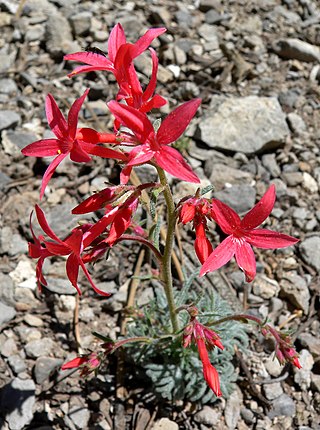
Ipomopsis arizonica is a flowering plant in the family Polemoniaceae, native to the mountains of the Mojave Desert sky islands from southeastern California east through southern Nevada to northern Arizona, growing at 1500–3100 meters in elevation. It is found in rocky places in the desert, as well as washes.
Hackelia bella is a species of flowering plant in the borage family known by the common name greater showy stickseed.

Ipomopsis congesta is a species of flowering plant in the phlox family, known by the common name ballhead ipomopsis. It is native to much of western North America, where it grows in many habitats from alpine peaks to low-elevation scrub. It is a perennial herb which varies in appearance, especially across subspecies and climates. It may take the form of a squat patch with stems under 10 centimeters in height or a more erect form up to 30 centimeters tall. The stems are often hairy to woolly. The thick leaves are usually fork-shaped with a number of clawlike lobes and 1 to 4 centimeters long. The flowers appear in a rounded, dense cluster atop the stem. Each flower is bell-shaped to funnel-shaped and white with a pale yellow throat and protruding yellow or white stamens. There are several subspecies, many of which were formerly considered species of Gilia.

Ipomopsis tenuifolia is a species of flowering plant in the phlox family known by the common name slenderleaf skyrocket, or slenderleaf ipomopsis. It is native to Baja California with its range extending just into California and Arizona, where it is a plant of the deserts and chaparral. This is a perennial herb taking the form of a neat clump of slender, erect multibranched stems reaching a maximum height near 40 centimeters. The leaves are narrow to threadlike and occur all along the stem branches. The inflorescences appear at or near the tips of the branches and each holds one to seven bright scarlet flowers. Each flower is a tube 1 to 2 centimeters long opening into a flat or bell-shaped corolla with squared or toothed lobes. The five stamens and one style protrude far out of the mouth of the flower. The stamens have white to purple anthers and the style has three whitish stigmas.

Lepidium fremontii, the desert pepperweed, is a species of flowering plant in the mustard family which is native to the southwestern United States, where it grows on sandy desert flats and the rocky slopes of nearby hills and mountains. It takes its scientific name from John C. Frémont.
Loeseliastrum depressum is a species of flowering plant in the phlox family known by the common name depressed ipomopsis. It is native to the deserts of the southwestern United States, where it grows in sandy habitat. It is a petite, decumbent annual herb forming a small clump on the ground, its hairy, glandular stems no more than 10 centimeters long. The leaves are linear to oval and pointed, each not more than 2 centimeters long. They are coated in white hairs. The inflorescence is a dense cluster of tiny white flowers, each pointed corolla lobe just a millimeter long or so.
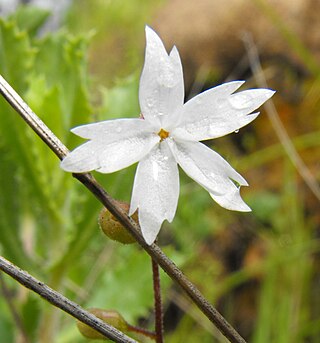
Lithophragma affine is a species of flowering plant in the saxifrage family known by the common name San Francisco woodland star. It is native to the coast of western North America from Oregon to Baja California, where it grows in open habitat on mountain slopes, hills, and canyonsides. It is a rhizomatous perennial herb growing erect or leaning with a tall naked flowering stem. The leaves are located on the lower part of the stem, each divided into sharp-pointed lobes. The stem bears up to 15 widely spaced flowers, each in a cuplike calyx of red or green sepals. The five petals are bright white, up to 1.3 centimeters long, and divided into three toothlike lobes at the tips.
Lithophragma campanulatum is a species of flowering plant in the saxifrage family known by the common name Siskiyou Mountain woodland star. It is native to southern Oregon and northern California, where it grows in the forests and woods of the mountains. It is a rhizomatous perennial herb growing erect or leaning with a tall naked flowering stem. The leaves are mostly located on the lower part of the stem, each divided into rounded lobes, sometimes narrowed into teeth. The stem bears 2 to 11 flowers, each in a cuplike calyx of red or green sepals. The five petals are white, under one centimeter long, and divided into irregular toothlike lobes.

Lithophragma heterophyllum, commonly known as hillside woodland star, is a species of flowering plant in the saxifrage family found in the western United States. It is native to the coastal mountain ranges of California, where it can generally be found in shady habitat. It is a rhizomatous perennial herb growing erect or leaning with a slender naked flowering stem. The leaves are located on the lower part of the stem, each divided into rounded lobes. The stem bears 3 to 12 flowers, each in a cuplike calyx of red or green sepals. The five petals are white, up to 1.2 centimeters long, and usually divided into about three pointed lobes.

Parnassia californica is a species of flowering plant in the family Celastraceae known by the common name California grass of Parnassus. It is native to the mountains of Oregon, California, and Nevada, where it grows in moist areas such as meadows and streambanks.

Pedicularis centranthera is a species of flowering plant in the family Orobanchaceae known by the common names dwarf lousewort and Great Basin lousewort. It is native to the western United States from eastern Oregon and California to Colorado and New Mexico, where it grows in sagebrush and other basin and plateau habitat. It is a perennial herb producing several short stems a few centimeters tall from a basal caudex. The leaves are up to 20 centimeters long, lance-shaped and divided into many overlapping toothed, wrinkled, or fringed lobes. The inflorescence is a short raceme bearing many long, protruding, club-shaped flowers. Each flower may exceed 4 centimeters in length and is white or pale purple with dark purple tips on the wide ends of its upper and lower lips. The sepals of the flowers are shorter and hairy. The fruit is a capsule around centimeter long containing seeds with netlike surfaces.

Reseda alba is a species of flowering plant in the reseda family known by the common names white mignonette or white upright mignonette. It is native to Europe, Asia, and North Africa, and it can be found in parts of the Americas and Australia as an introduced species. It is also cultivated as an ornamental plant for its spikelike racemes of fragrant white flowers. This is an annual or perennial herb growing up to a meter tall. The leaves are divided deeply into many narrow lobes. The inflorescence, which may take up most of the upper stem, is densely packed with many white flowers. Each flower has five or six petals, each of which is divided into three long, narrow lobes, making the raceme appear frilly. The fruit is a nearly rectangular four-angled capsule up to 1.4 centimeters in length.
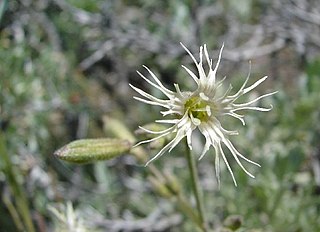
Silene oregana is a species of flowering plant in the family Caryophyllaceae known by the common names Oregon silene, Oregon campion and Oregon catchfly. It is native to the western United States, including the Great Basin, where it grows in habitat such as sagebrush and forests. It is a perennial herb growing from a woody caudex and taproot, sending up an erect, mostly unbranched stem which may be 70 centimeters tall. The lance-shaped leaves are up to 8 centimeters long around the caudex, and shorter farther up the stem. Flowers occur in a terminal cyme and sometimes in leaf axils. Each flower is encapsulated in a hairy, glandular calyx of fused sepals. The five petals are creamy white or pink-tinged in color and each has four to six long, fringelike lobes at the tip.
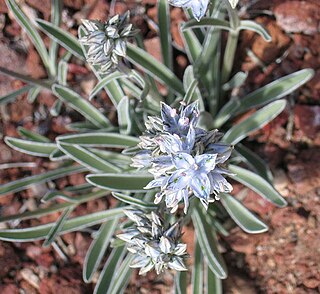
Frasera albicaulis is a species of flowering plant in the gentian family known by the common name whitestem frasera. It is native to the northwestern United States, where it grows in open areas in mountain habitat. It is a perennial herb growing from a woody base surrounded by rosettes of leaves, its stem growing 10 to 70 centimeters tall. The leaves are green with white margins. The basal leaves are lance-shaped, up to 30 centimeters long, and borne on petioles. Leaves higher on the stem are smaller and narrower and are oppositely arranged. The inflorescence is a dense panicle atop the stem, sometimes interrupted into a series of clusters of flowers. Each flower has a calyx of four pointed sepals and a corolla of four pointed lobes each one half to one centimeter long. The corolla is pale greenish white to light blue to purple, often dotted, streaked, or veined with darker blue. There are four stamens tipped with large anthers and a central ovary.
Frasera neglecta is a species of flowering plant in the gentian family known by the common name pine green gentian.
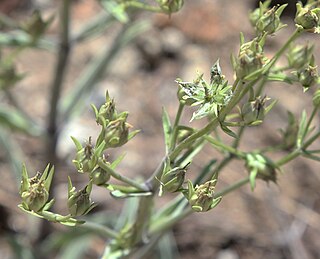
Frasera puberulenta is a species of flowering plant in the gentian family known by the common name Inyo frasera.
Frasera tubulosa is a species of flowering plant in the gentian family known by the common name Kern frasera.

Ipomopsis sancti-spiritus is a rare species of flowering plant in the phlox family known by the common name Holy Ghost ipomopsis. It is endemic to New Mexico in the United States, where it is known from only one canyon in the Sangre de Cristo Mountains. It is a federally listed endangered species.
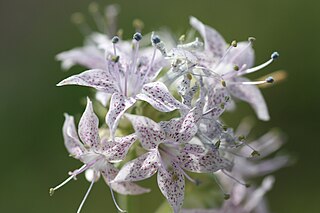
Ipomopsis polyantha is a rare species of flowering plant in the phlox family known by the common names Pagosa ipomopsis, Pagosa skyrocket and Archuleta County standing-cypress. It is endemic to Colorado in the United States, where it occurs only in the vicinity of Pagosa Springs in Archuleta County. It is threatened by the loss of its habitat to residential and commercial development. It was federally listed as an endangered species in 2011.
Ipomopsis globularis is a species of flowering plant in the phlox family known by the common name Hoosier Pass ipomopsis. It is endemic to Colorado in the United States, where it grows in the Rocky Mountains.














